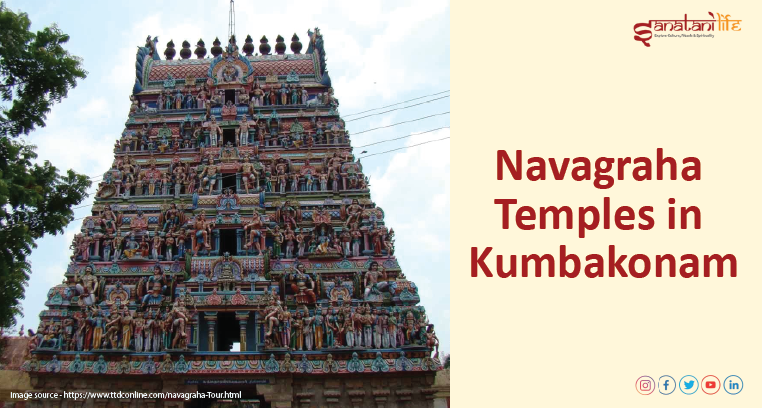Navagraha Temples Near Kumbakonam
In Tamil Nadu, the Navagraha Temples at Kumbakonam are a special and spiritually important pilgrimage route dedicated to the nine celestial bodies (Navagrahas) that shape human fate. These temples are a popular destination for those looking for astrological cures, spiritual comfort, and cultural enrichment. They are situated in the culturally diverse state of Tamil Nadu.
Thank you for reading this post, don't forget to subscribe!
The Navagraha Temples’ Mythology
In Hindu mythology, the Navagraha Temples have a strong foundation. Ancient traditions claim that because of their influence on the lives and fates of people, the Navagrahas were given celestial status. These temples, which are thought to have been sanctified by Lord Shiva, are important locations for requesting blessings from the heavens and reducing planetary doshas.
Worshipping these deities is believed to provide balance and harmony to one’s life, and each temple symbolizes the distinctive qualities of a planet. These temples are a vital component of Tamil Nadu’s identity as their mythology is entwined with the state’s spiritual and cultural legacy.
The Importance of the Temples of Navagraha
Devotees and pilgrims from all over the nation are drawn to the Navagraha Temples at Kumbakonam because of its tremendous significance in Hinduism and astrology. Each of the nine celestial bodies (Navagrahas)—Surya (Sun), Chandra (Moon), Chevvai (Mars), Budhan (Mercury), Guru (Jupiter), Shukra (Venus), Shani (Saturn), Rahu, and Ketu—that are said to regulate different facets of human existence are honored in these temples.
1. Spiritual Importance
The Navagraha Temples are regarded as potent hubs of heavenly energy. In these temples, worshiping the planetary deities is thought to:
- Eliminate bad energy and cleanse the spirit.
- Bring inner serenity and spiritual enlightenment.
- Align karma with cosmic powers to assist devotees in overcoming life’s challenges.
2. The Significance of Astrology
Hinduism places a strong emphasis on astrology, and navagraha temples are closely linked to astrological cures.
- Many people go to these temples in order to lessen the negative effects of the planetary doshas (malefic influences) that are present in their birth charts.
- Increasing Positivity: The beneficial benefits of fortunate planets can be amplified by worshiping particular deities.
- Remedial Rituals: To enhance planetary alignments, astrologers frequently suggest pariharams (remedies) including burning lights, presenting certain grains or flowers, and doing pujas at these temples.
3. Cultural Importance
Tamil Nadu’s rich cultural heritage is reflected in the Navagraha Temples.
- Architectural Wonders: With its elaborate carvings, soaring gopurams, and exquisite sculptures that tell Hindu myths, each temple is a monument to the Dravidian architectural style.
- Festivals & Celebrations: The temples serve as focal points for yearly festivals that draw thousands of devotees and tourists, including Maha Shivaratri, Navaratri, and others.
4. The Significance of Mythology
Ancient Hindu texts and mythology abound at the Navagraha Temples.
- According to legend, the Navagrahas were given heavenly status and their own temples so that followers might worship them for blessings and direction.
- The Puranas tell stories about the Navagrahas’ influence on human fate and the spiritual advantages of worshipping these heavenly beings.
5. Function in Tourism and Pilgrimage
One of the main attractions of Tamil Nadu’s religious tourism is the Navagraha Temples.
- Navagraha Pilgrimage: Visiting these temples is regarded as an important spiritual endeavour. Pilgrims travel this path in search of spiritual development, karmic weight reduction, and heavenly favours.
- Kumbakonam Temple Tour: The Navagraha circuit is frequently coupled with tours of other well-known temples in the area, such Adi Kumbeswarar Temple and Brihadeeswarar Temple.
6. Psychological and Healing Advantages
Visiting the Navagraha Temples provides psychological and therapeutic advantages in addition to spiritual and astrological ones:
- Stress Reduction: These temples’ calm surroundings, which are frequently encircled by nature, offer a peaceful respite from the stresses of everyday life.
- Healing abilities: Rituals are frequently carried out in temples like Vaitheeswaran Koil for both bodily and mental well-being because it is said that these places have healing abilities.
- Faith and Hope: Many devotees find that going to these temples gives them a sense of hope and faith that helps them get through difficult times in life.
About the Temples of Navagraha
Every Navagraha Temple in Kumbakonam is distinct, honoring a particular celestial being and having great spiritual and astrological importance.
1. Sun Temple, or Suriyanar Koil
- Deity: Sun God, Surya
- Significance: This place of worship fosters life, strength, and leadership.
- The temple’s sanctuary, where Surya’s deity rides a chariot drawn by seven horses, is one of its distinctive characteristics. Offerings consist of jaggery, wheat, and red flowers.
- Timings: 6:00 AM to 12:00 PM and 4:00 PM to 8:00 PM
2. Chandran/Moon Temple, also known as Kailasanathar Temple
- Deity: Moon God Chandra
- Significance: Linked to mental clarity and emotional health.
- Special Features: Chandra is served milk for peace and tranquility, and the temple has a quiet atmosphere.
- Timings: 6:00 AM to 12:00 PM and 4:00 PM to 8:00 PM
3. Mars Temple, also known as Vaitheeswaran Koil
- Deity: Mars’ Chevvai
- Significance: Well-known for its ability to cure and provide health benefits.
- Special Features: Pilgrims use sacred ash in ceremonies and offer prayers for the healing of illnesses.
- Timings: 6:00 AM to 1:00 PM and 4:00 PM to 9:00 PM
4. The Temple of Swetharanyeswarar (Mercury Temple)
- Buddha (Mercury) is the deity.
- Significance: Improves financial stability, intelligence, and communication abilities.
- Special Features: The temple is well-known for its colorful festivals and elaborate sculptures.
- Timings: 6:00 AM to 12:00 PM and 4:00 PM to 8:00 PM
5. Thirunageswaram Temple (Rahu Temple)
- The god is Rahu
- Significant because he removes negative planetary impacts and fosters wealth.
- Unique Features: When the milk spilled during Abhishekam becomes blue, devotees find it fascinating.
- Timings: 6:00 AM to 1:00 PM and 4:00 PM to 9:00 PM
6. Naganathaswamy Temple God, also called Ketu Temple:
- God: Ketu
- Significance: Promotes spiritual growth and the redemption of karmic debt.
- Special Features: Known for its statues of snakes and serene settings.
- Timings: 6:00 AM to 12:00 PM and 4:00 PM to 8:00 PM
7. Temple of Alangudi (Saturn Temple)
- Deity: Saturn, or Shani
- Significance: Provides patience, discipline, and respite from adversity.
- Special Features: Lamps with gingelly oil, black cloth, and sesame seeds are offered by devotees.
- Timings: 4:00 PM to 8:00 PM and from 6:00 AM to 1 PM.
Route Map for Kumbakonam Navagraha Temple
In Tamil Nadu, route planning is crucial for a successful Navagraha pilgrimage. All of the temples are within a 30- to 40-kilometer radius of Kumbakonam, which acts as the center. Take this route to begin your travel from Kumbakonam:
Suriyanar Koil → Kailasanathar Temple → Vaitheeswaran Koil → Swetharanyeswarar Temple
Agniswarar Temple → Apatsahayesvarar Temple → Thirunageswaram → Naganathaswamy Temple
End at Alangudi Temple
How to Go to the Temples of Navagraha
- By Air: Trichy, which is around 91 kilometres from Kumbakonam, has the closest airport.
- By Train: Major cities are easily accessible from Kumbakonam Railway Station.
- By Road: Convenient choices include rental cars, buses, and private taxis.
Spiritual Places in Tamil Nadu
There are several other places of worship in Tamil Nadu besides the Navagraha Temples:
- A UNESCO World Heritage Site is the Brihadeeswarar Temple.
- The temple of Rameshwaram is a revered Jyotirlinga.
- Chidambaram Temple: Well-known for Lord Shiva’s cosmic dance.
Temples of Navagraha: A Unique Puja
Every temple honors the Navagrahas with their own pujas.
- Navagraha Shanti Puja: Reduces the effects of planetary doshas.
- Using milk, turmeric, and holy water, abhishekam is performed.
- Archana: Recitation of a deity-specific mantra.
The Ideal Time to Visit the Temples of Navagraha
October through March is the best time of year to visit the Navagraha Temples in Kumbakonam because of the nice and travel-friendly weather.
- October through November: The post-monsoon season brings with it verdant scenery and a revitalizing atmosphere. For nature lovers who appreciate both spiritual experiences and natural beauty, this is a great time of year.
- December to February: Tamil Nadu’s winter season, which runs from December to February, is distinguished by moderate, pleasant weather that make it suitable to visit temples and explore the outdoors. Since many temple festivals, such as the festivities of Margazhi month, draw devotees, this is also the busiest time of year for pilgrims.
- March: Because of the warm early spring temperatures, visitors may easily do the Navagraha temple circle without the challenges of extreme heat or humdity.
Activities Near to the Temples of Navagraha
There is more to a trip to Kumbakonam’s Navagraha Temples than merely a spiritual encounter. Travelers may engage in a range of activities in the surrounding areas to fully experience the rich cultural, natural, and traditional appeal of the area.
1. Explore the Temples in the Area
Because of its large number of ancient temples, Kumbakonam is sometimes known to as the “Temple Town.” Other than the Temples of Navagraha, you can go to:
- A UNESCO World Heritage Site, Brihadeeswarar Temple is renowned for its Chola architecture and magnificence.
- Kumbakonam gets its name from the Adi Kumbeswarar Temple, which is devoted to Lord Shiva.
- Mahamaham Tank: A revered water tank connected to the festival of Mahamaham.
2. Take Part in Festivals of Culture
Tamil Nadu is well known for its colorful celebrations. Plan your visit to take place during:
- The Navagraha Temples celebrate Maha Shivaratri with splendor.
- The Margazhi Festival includes rituals, traditional dances, and religious music.
- Panguni Uthiram: Well-known for its rituals and processions at neighboring temples.
3. Savor the Customary Tamil Food
A delicious variety of traditional Tamil food is available in Kumbakonam and the nearby villages. Don’t overlook:
- Kumbakonam Degree Coffee: Well-known for its distinct preparation and flavor.
- Banana Leaf Meals, Pongal, Dosa, and Idli are examples of traditional foods.
4. Purchasing Memorabilia
Purchase traditional goods that honor the history of Tamil Nadu:
- Handcrafted brass lamps and utensils from neighboring communities.
- Temple Jewelry: Symbolic and elaborate designs based on temple themes.
- Beaded Rudraksha and NavagrahaAssociated Products: accessible close to the temples.
5. Tours of the Village
Discover the charm of rural Tamil Nadu by touring the tranquil villages surrounding Kumbakonam:
- Take in traditional handicrafts such as weaving and pottery.
- Engage in conversation with locals to discover their traditions and lifestyle.
- Engage in agricultural pursuits, such as tours of rice paddies.
6. Take Pleasure in Photography and Beautiful Nature Walks
The temples are perfect locations for nature hikes and photography because they are encircled by rich vegetation:
- Take in the temples’ elaborate sculptures and Dravidian architecture.
- Wander around the riverbanks and paddy fields that border the temple pathways.
7. Go to Mahamaham Tank 7.
- A must-see location in Kumbakonam is this holy water tank, which is thought to atone for sins.
- Encircled by little shrines, it comes to life once every twelve years during the Mahamaham Festival.
8. Watching birds
- There are prospects for birding in the rural regions close to Kumbakonam.
- See local animals in their natural habitat, such peacocks or Indian rollers.
9. Tours of Temple Architecture
The Navagraha Temples provide a wealth of information about Tamil Nadu’s architectural heritage for anyone who are interested in history and art. Examine:
- The tall temple gates, or gopurams.
- Elaborate sculptures that tell Hindu mythological tales.
- Ancient inscriptions that give the temples’ historical background.
FAQs Regarding Navagraha Temples Close to Kumbakonam
Q-1. What distinguishes the Kumbakonam Navagraha Temples from other Indian temples?
Ans. The Navagraha Temples are a rare and significant pilgrimage circuit for individuals looking for planetary blessings and remedies since they are exclusively devoted to the nine celestial bodies in Hindu astronomy.
Q-2. Are there particular times or days that are preferable for spiritual advantages when visiting the Navagraha Temples?
Ans. Although the temples are accessible every day, it is thought to be more advantageous to attend on days that are favorable for the particular planet, such as Saturdays for Saturn or Sundays for the Sun. Prayer is also best during sunrise and sunset.
Q-3. Is it possible for me to see every Navagraha temple in a single day?
Ans. Spreading out the trips over two or three days is more pleasant and spiritually enlightening, even if it is feasible to see all nine temples in a single day with meticulous preparation and early starts.
Q-4. Are the Navagraha Temples accessible to the elderly or wheelchair-accessible?
Ans. Although not all Navagraha Temples have wheelchair-accessible facilities, the majority are. Checking ahead of time is advised, particularly for people with mobility issues.
Q-5. Does access to the Navagraha Temples have any limitations?
Ans. Regardless of ethnicity or creed, all devotees are welcome to visit the temples. However, entrance requires modest clothing and adherence to temple traditions.
Q-6. Is there a certain order in which one should visit the temples of Navagraha?
Ans. Although there is no hard-and-fast rule, many pilgrims begin at Suriyanar Koil (Sun Temple) and proceed throughout the circle according to their astrological or personal inclinations. Speaking with a local guide or astrologer might be beneficial.





